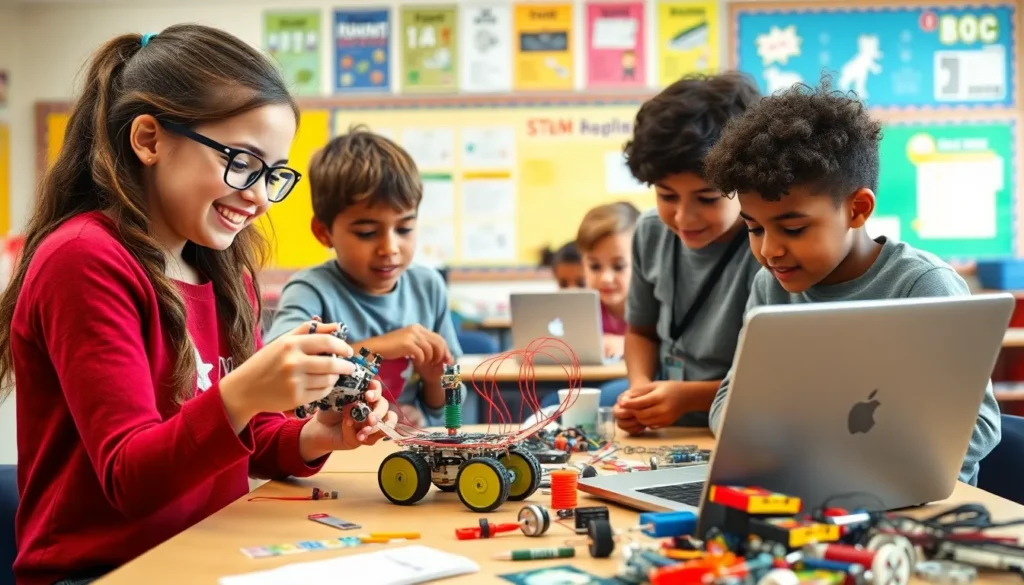Table of Contents
ToggleIn a world where tech rules and science is the new rock star, the STEM curriculum is like the backstage pass to the future. It’s not just about crunching numbers or mixing chemicals; it’s about unleashing creativity and critical thinking in ways that would make even Einstein do a happy dance. Imagine a classroom where students design robots, solve real-world problems, and maybe even discover the next big thing—like a toaster that also makes coffee.
Overview of Stem Curriculum
The STEM curriculum integrates science, technology, engineering, and mathematics, preparing students for a rapidly changing world. This educational framework focuses on developing problem-solving skills through interactive and practical experiences.
Definition and Importance
STEM education emphasizes an interdisciplinary approach, merging theory with practice. It fosters critical thinking and creativity, essential in today’s job market. Employers increasingly seek candidates skilled in these areas, as innovation drives economic growth. Studies show that students engaged in STEM activities exhibit higher interest in these subjects. Consequently, a strong STEM curriculum encourages continuous learning and adaptability.
Key Components of Stem Curriculum
Hands-on projects form a core element of the STEM curriculum, enabling students to apply knowledge in real-world contexts. Experimentation in science allows for deeper understanding while technology lessons enhance digital literacy. Engineering principles cultivate design skills, and mathematics provides essential quantitative tools. Collaboration among students reinforces teamwork, preparing them for collaborative work environments. Integration of these components fosters a holistic educational experience, fueling future success in STEM fields.
Benefits of Implementing Stem Curriculum

Implementing a STEM curriculum provides numerous educational benefits that prepare students for future challenges. This innovative approach emphasizes skill development and engagement in real-world applications.
Enhancing Critical Thinking Skills
Critical thinking skills grow through STEM education. Students tackle complex problems and analyze data, enhancing their ability to think independently. Engaging in experiments allows learners to test hypotheses and draw conclusions based on evidence. This hands-on approach encourages students to question assumptions and explore diverse solutions. As they navigate challenges, their decision-making abilities strengthen. In turn, these skills increase student confidence in tackling unfamiliar situations.
Fostering Collaboration and Creativity
Collaboration thrives in a STEM environment. Students regularly work in teams, sharing ideas and perspectives to complete projects. This teamwork cultivates communication skills and the ability to adapt to others’ viewpoints. Creativity sparks during collaborative efforts as diverse thoughts lead to innovative solutions. In addition, students often engage in brainstorming sessions, which encourage out-of-the-box thinking. These collaborative experiences develop social skills and build a supportive learning community, essential for success in the modern workforce.
Challenges in Stem Curriculum Adoption
Adopting a STEM curriculum faces several significant challenges that can hinder effective implementation.
Curriculum Development Issues
Developing a STEM curriculum poses complexities due to the need for an interdisciplinary approach. Many educational institutions lack a cohesive framework that integrates science, technology, engineering, and mathematics seamlessly. Curriculum gaps often arise, leading to inconsistencies in student learning experiences. Moreover, educators may encounter difficulties in aligning curriculum objectives with state standards while also ensuring relevance to real-world applications. Time constraints significantly restrict opportunities for the thorough development of engaging, hands-on projects. Consequently, these challenges can limit the effectiveness and appeal of STEM education.
Teacher Training and Resources
Training teachers for STEM education presents its own set of challenges. Many educators do not receive adequate professional development focused on STEM teaching methods, impacting their confidence and effectiveness in the classroom. Access to quality resources, including materials and technology, is often limited, restricting hands-on learning experiences. Schools may struggle to provide the necessary tools for teachers to implement innovative lessons effectively. As a result, teacher preparedness directly affects student engagement and success in STEM fields. Institutions must prioritize ongoing support and resources to enhance teacher capabilities in delivering impactful STEM education.
Successful Case Studies
Numerous successful case studies highlight the effectiveness of STEM curricula in various educational settings. These examples demonstrate innovative approaches and significant outcomes.
Notable Programs and Schools
Several schools and programs set benchmarks in STEM education. Project Lead The Way, for instance, offers engaging curricula focused on pre-engineering concepts. The School of Science and Technology in Texas integrates hands-on experiences across all grade levels, cultivating a strong interest in science and engineering. Montclair State University’s STEM program emphasizes collaboration with local industries, providing students real-world project experience. These programs demonstrate how interdisciplinary methods in STEM education enhance student learning and prepare them for future careers.
Impact on Student Engagement and Achievement
Engagement levels often rise significantly in STEM-focused classrooms. Surveys indicate that over 85% of students exhibit increased interest in STEM subjects due to hands-on projects. Research shows students participating in these programs outperform peers in standardized assessments by an average of 20%. Such achievements correlate with improved problem-solving skills and critical thinking. Students learn to approach challenges creatively and collaboratively, which boosts their confidence and academic performance. Data also reveals increased enrollment in advanced STEM courses following exposure to effective STEM curricula.
Future of Stem Curriculum
The future of STEM curriculum promises transformative changes driven by emerging trends and innovations.
Trends and Innovations
Growing integration of artificial intelligence and robotics in educational settings enhances engagement and interactivity. Curriculum designers are increasingly incorporating project-based learning to promote critical thinking and teamwork. Data analytics play a crucial role in shaping personalized learning experiences, helping educators tailor approaches to individual student needs. Digital tools are becoming more prevalent, allowing for virtual labs and remote collaboration among students. Approximately 85% of students report heightened interest in STEM activities, underscoring the effectiveness of these innovative methods. Experiential learning projects, such as coding and engineering challenges, are fostering creativity and real-world problem-solving skills.
Predictions for Educational Systems
Educational systems will likely prioritize interdisciplinary approaches to address complex, real-world challenges. Increased collaboration between schools and local industries is expected to provide students with relevant experiences that directly connect classroom learning to career opportunities. Professional development for educators will remain a crucial focus, ensuring they are equipped with the latest teaching strategies and technologies. Many predict that comprehensive STEM curricula will become standard, reflecting the growing demand for STEM skills in the job market. Data indicates students exposed to effective STEM programs consistently outperform peers by 20%, reinforcing the need for widespread adoption. This evolution will also enhance digital literacy, preparing students for a technology-driven future.
The STEM curriculum is undeniably vital in shaping the future of education and the workforce. By fostering creativity and critical thinking through hands-on projects and real-world applications, students are better prepared for the challenges ahead. The integration of science, technology, engineering, and mathematics not only enhances problem-solving skills but also promotes teamwork and communication.
As educational institutions navigate the complexities of implementing effective STEM programs, the focus on teacher training and resource availability remains crucial. Successful case studies illustrate the positive impact of well-designed STEM curricula on student engagement and achievement. Embracing these innovative educational approaches will ensure that students are equipped with the skills necessary for success in an increasingly technology-driven world.







